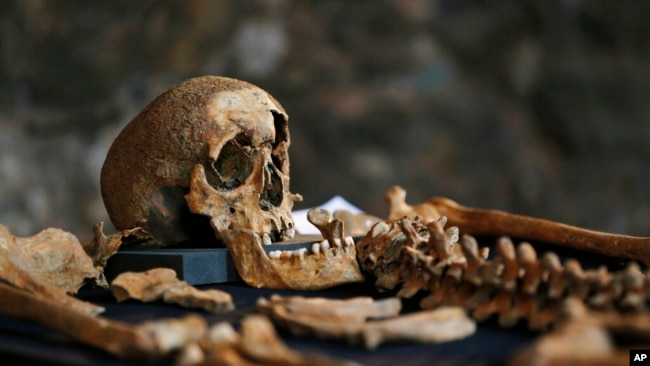'블랙 데스'는 중앙아시아에서 기원한 것으로 보인다고 연구원들은 말합니다.
'Black Death' Likely Originated in Central Asia, Researchers Say
페이지 정보
작성자 Elise Cutts 작성일 22-06-22 17:39 댓글 0본문

파일 - 2014년 3월 26일 런던 중심부에서 건설 작업 중 발견된 25개의 골격 중 일부가 사진에 찍혀 있습니다. 고고학자들은 이 뼈들이 14세기 흑사병 희생자들을 위한 공동묘지에서 나온 것이라고 의심했습니다.
FILE - Parts of one of 25 skeletons found during construction work in central London are pictured, March 26, 2014. Archaeologists suspected the bones came from a cemetery for Black Death victims in the 14th century.
새로운 연구에 따르면, 대략 1346년부터 1353년까지 서부 유라시아에서 최대 60%의 사람들을 죽인 흑사병은 중앙 아시아의 톈산 산맥에서 기원한 것으로 보입니다.
The Black Death, a plague that killed up to 60% of people in western Eurasia from roughly 1346 to 1353, likely originated in the Tian Shan mountains of central Asia, new research shows.
과학자들은 14세기 키르기스스탄의 두 공동묘지에 묻힌 인간의 유해에서 페스트를 일으키는 박테리아인 예르시니아 페스티스의 고대 변종의 게놈 두 개를 발견했습니다. 이 균주는 흑사병을 일으킨 미생물의 조상입니다.
Scientists recovered two genomes of an ancient strain of Yersinia pestis, the bacterium that causes plague, from human remains buried in two 14th-century cemeteries in Kyrgyzstan. The strain is the ancestor of the microbes that caused the Black Death.
"흑사병의 기원은 중세 역사에서뿐만 아니라 역사상 가장 널리 논의된 주제 중 하나였습니다. 하지만 저는 흑사병이 역사상 가장 논쟁적인 주제 중 하나였다고 해도 과장하지 않을 것입니다," 라고 역사학자이자 연구 공동 저자인 스털링 대학의 필립 슬라빈이 말했습니다.
“The origin of the Black Death has been one of the most widely debated topics not only in medieval history, but I perhaps will not exaggerate if I say that it has been one of the most debated topics in history, period,” said historian and study co-author Philip Slavin of the University of Stirling.
많은 경쟁 이론들이 있지만, "고대 DNA가 없었다면, 여러분은 실제로 그 이론들 중 하나를 확인할 수 없었을 것입니다"라고 그는 말했습니다.
There are many competing theories, he said, “but without ancient DNA, you wouldn't be able actually to confirm one of those theories.”
연구원들은 2011년 런던의 한 매장지에서 나온 샘플을 사용하여 고대 Y. 페스티스 게놈을 처음으로 재구성했습니다. 그 이후로, 서부 유라시아에서 온 몇 개의 추가 흑사병 게놈과 설치류에 의해 운반된 현대 Y. 페스트균의 더 많은 게놈들 - 페스트의 자연적인 저장고 - 또한 염기서열 분석되었습니다.
Researchers reconstructed an ancient Y. pestis genome for the first time in 2011 using samples from a burial ground in London. Since then, a handful of additional Black Death genomes from western Eurasia and many more from modern Y. pestis strains carried by rodents and their parasites — the natural reservoirs of plague — also were sequenced.
하지만 새로운 자료에도 불구하고, "이러한 종류의 연구가 모든 것이 어디에서 시작되었고 언제 시작되었는지에 대해 우리에게 많은 것을 말해주지 않는다는 것은 우리에게 여전히 꽤 명백합니다"라고 새로운 연구의 첫 번째 저자인 Eberhard Karls University의 생물학자인 Maria Spyrou는 말했습니다.
But even with the new data, “it was still quite clear to us that this kind of research was not really telling us much about where it all started and when it all started,” said Maria Spyrou, a biologist at the Eberhard Karls University of Tübingen and first author of the new study.
사망자가 급증했습니다.
Spike in deaths
흑사병의 샘은 유럽의 무덤에서는 발견되지 않을 것입니다. 하지만 슬라빈은 키르기스스탄의 잇시크쿨 호수 근처에 있는 두 개의 묘지가 유망해 보인다고 생각했습니다. 묘비 비문을 바탕으로, 그 지역은 1338년과 1339년 사이에 사망자가 급증했습니다. 그 사망자들 중 일부는 알려지지 않은 "발작"의 탓으로 돌려졌습니다.
The wellspring of the Black Death wouldn’t be found in a European grave. But Slavin thought that two cemeteries near Lake Issyk-Kul in Kyrgyzstan looked promising. Based on tombstone inscriptions, the area saw a spike in deaths between 1338 and 1339. Some of those deaths were blamed on an unknown “pestilence.”
연구원들은 공동묘지에 묻힌 7명의 사람들의 7개의 치아에서 유전 물질을 추출하고 배열했습니다. 사람의 치아는 혈관의 촘촘한 그물망으로 교차되어 있어서, Y. pestis와 같은 혈액 매개 병원체의 수세기 된 DNA를 찾는 가장 좋은 장소 중 하나입니다. 7명의 사람들 중 3명은 이빨에 페스트 DNA를 가지고 있어서, 연구원들은 그들을 죽인 균주의 게놈을 재구성할 수 있었습니다.
The researchers extracted and sequenced genetic material from seven teeth from seven individuals buried at the cemeteries. Human teeth are crisscrossed by a dense network of blood vessels, making them one of the best places in which to look for the centuries-old DNA of blood-borne pathogens like Y. pestis. Three of the seven individuals had plague DNA in their teeth, allowing researchers to reconstruct the genome of the strain that killed them.
이 페스트의 유전적 가계도에서, 이 새로운 변종은 Spyrou가 "유전 다양성의 폭발"이라고 부른 것의 바로 밑바탕에 자리잡고 있습니다. 이것은 흑사병을 일으킨 변종들을 포함한 새로운 변종의 극적인 방사선이었습니다. 기원의 가장 가까운 근대의 사촌들은 톈산 지역의 마멋에 의해 운반되기 때문에 지역적으로 발전한 것으로 보입니다.
In a genetic family tree of the plague, the new strain sits right at base of what Spyrou called an “explosion of genetic diversity” — a dramatic radiation of new strains including the ones that caused the Black Death. The origin strain’s closest modern cousins are carried by marmots in the surrounding Tian Shan area, so it seems to have developed locally.
"그것은 중앙 아시아의 톈산 지역에서 시작되었을 가능성이 높습니다,"라고 Spyrou는 말했습니다. "하지만 고고학적 기록을 사용하는 것은 거의 불가능하기 때문에, 저는 잘 모르겠습니다만, 우리가 0번 환자나 0번 발생자를 발견했다고 주장하고 싶지는 않습니다."
“It started most likely in this Tian Shan region of central Asia,” said Spyrou. “But I don’t want to claim that we have found, I don’t know, a patient zero or outbreak zero, because this is almost impossible using the archaeological record.”
사우스 캐롤라이나 대학의 고고학자인 샤론 드윗은 그 결과에 흥분했지만, 그녀는 흑사병이 다른 곳에서 중앙 아시아에 도달했을 가능성은 여전히 작다고 말했습니다.
Sharon DeWitte, an archaeologist at the University of South Carolina, was excited by the results, but she noted that there’s still a small chance the Black Death reached central Asia from elsewhere.
"예르시니아 페스트균은 어떤 유전적 변이도 축적하지 않고 꽤 멀리 이동할 수 있습니다," 라고 그녀가 말했습니다. "하지만 그렇다고 해서, 그 일반적인 지역이 기원이었다는 강력한 증거가 있습니다."
“Yersinia pestis can travel pretty far without accumulating any genetic variation,” she said. “But that being said, there's strong evidence that that general area was the origin.”
왜, 어떻게 퍼졌을까요?
Why, how did it spread?
흑사병이 시작된 곳을 찾는 것은 왜 그리고 어떻게 그것이 동물에서 인간으로 흘러 넘쳤고 14세기에 그렇게 재앙적으로 퍼졌는지를 이해하기 위한 중요한 단계입니다. 슬라빈은 무역이 중요한 요인이었다고 의심하고 있습니다.
Finding where the Black Death began is a major step toward understanding why and how it spilled over from animals to humans and spread so catastrophically in the 14th century. Slavin suspects trade was an important factor.
"이 공동체는 실크로드라고 알려진 장거리 무역로의 중심에 위치해 있었습니다,"라고 그는 말했습니다. 그들은 "매우 국제적이고, 매우 다국적적이며, 매우 다민족적이며, 많은 지리적 이동성을 가지고 있다"고 말했습니다.
“This community was situated right at the heart of long-distance trade routes known as the Silk Road,” he said. They were “extremely cosmopolitan, very multinational, very multiethnic, and [had] lots of geographic mobility.”
무덤에는 태평양과 인도양의 진주, 중국이나 우즈베키스탄의 비단, 지중해의 조개껍데기가 있었다고 슬라빈은 말했습니다.
Graves contained pearls from the Pacific and Indian oceans, silks from China or Uzbekistan and shells from the Mediterranean, said Slavin.
Spyrou와 DeWitte는 기후도 관련이 있을 수 있다고 말했습니다. 중앙 아시아의 역사적 기후 사건에 대한 향후 연구는 팬데믹의 시기 및 확산을 설명하는 데 도움이 될 수 있습니다. 아시아의 더 많은 고대 페스트 게놈들도 도움이 될 것이지만, 슬라빈은 유사한 고고학적 유적지나 수집품을 찾는 것은 말처럼 간단하지 않다고 언급했습니다.
Climate could also have been involved, said Spyrou and DeWitte. Future studies of historical climate events in central Asia could help explain the pandemic’s timing and spread. More ancient plague genomes from Asia also would help, but Slavin noted that finding similar archaeological sites or collections isn’t as straightforward as it sounds.
페스트는 여전히 매년 사람들을 죽입니다. 드위트에 따르면, 그것은 빠르게 진화하고 동물에서 사람으로 점프하기 때문에, 그것을 위험하게 만드는 조건을 이해하고 자세히 관찰하는 것이 중요하다고 합니다. 그리고 과거의 전염병을 연구하는 것은 현재에도 교훈을 줄 수 있습니다.
Plague still kills people every year. Because it evolves fast and jumps from animals to humans, it’s important to understand the conditions that make it dangerous and monitor it closely, according to DeWitte. And studying past pandemics can offer lessons for the present, too.
"흑사병은 기본적으로 우리가 영향을 받은 인간, 관련되었을지도 모르는 동물, 관련 박테리아, 그리고 기후 조건에 대한 엄청난 양의 데이터를 수집하는 자연적인 실험입니다."라고 드위트가 말했습니다. "그리고 저는 우리가 실제로 팬데믹 질병의 최악의 결과로 고통 받지 않도록 앞으로 나아가는 인구에 대한 회복력을 기르는 측면에서 이 모든 것이 정말 중요하다고 생각합니다."
“The Black Death is basically a natural experiment where we are gathering a huge amount of data about the human populations affected, the animals that might have been involved, the bacterium that was involved, and climate conditions,” said DeWitte. “And I think all that's really important in terms of building resilience for populations moving forward so that we don't actually suffer from the worst possible outcomes of pandemic disease.”
출처 : VOANews
- 이전글 코로나에 걸린 성인 5명 중 1명꼴로 증상이 지속되는 것으로 미국 연구소에서 밝혀졌습니다.
- 다음글 Microsoft: 러시아의 사이버 스파이 활동이 42명의 우크라이나 동맹국을 목표로 합니다.
댓글목록 0
등록된 댓글이 없습니다.

















